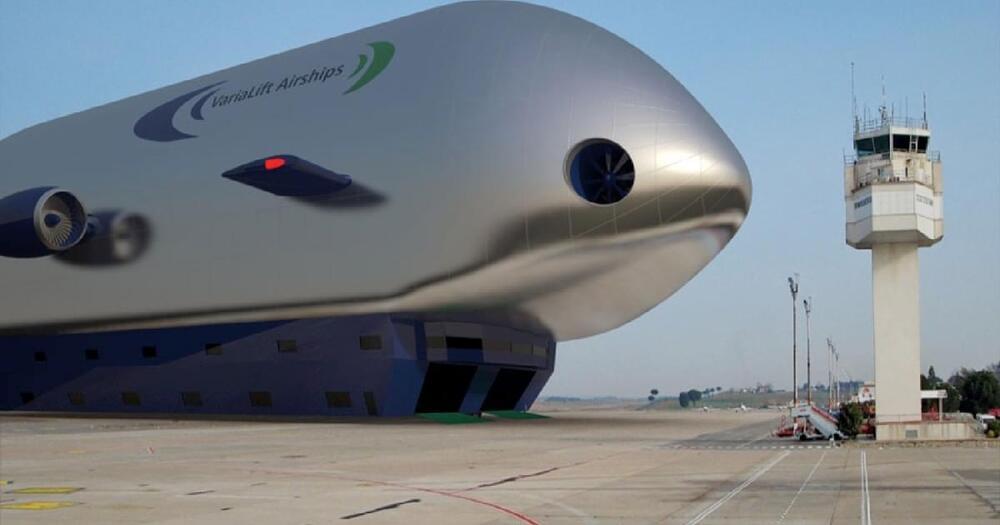Jupiter doesn’t have seasons, but it does have regular warm and cool cycles, according to 36 years of data from Voyager, Cassini, and ground-based telescopes.



Year 2019 face_with_colon_three
Zeppelins, the rigid airships most famously epitomized by the Hindenburg, now seem kind of retro, rather than the image of futurity they represented in the 1930s. But they could be about to make a comeback in a big way — courtesy of a new aluminum-shelled, solar-powered airship that’s being built by the U.K.-based company Varialift Airships.
According to the company’s CEO Alan Handley, the airship will be capable of making a transatlantic flight from the United Kingdom to the United States, consuming just 8% of the fuel of a regular airplane. It will be powered by a pair of solar-powered engines and two conventional jet engines.
While its lack of onboard battery would limit travel to daylight hours, and its speed will only be approximately half that of a Boeing 747, the Varialift airship does promise to be a useful cargo carrier. Its creators claim that it will be able to carry loads ranging from 50 to 250 tons. Larger models with payloads up to 3,000 tons aren’t out of the question either. Bulky cargo such as electricity pylons, wind turbine blades, and towers, or even prefabricated structures such as oil rigs could be carried underneath using cables. That means that cargo will have a weight limit, but no practical size limit.


But even junk has hidden treasures. Studies found variations in these unsequenced regions were intricately involved in human health, from aging to conditions like cancer and developmental disorders like autism. In 2022, a landmark study finally resolved the genomic unknown, completely sequencing the remaining eight percent of undeciphered DNA remaining.
Now, scientists are discovering that some genetic sequences encode proteins that lack any obvious ancestors, what geneticists call orphan genes. Some of these orphan genes, the researchers surmise, arose spontaneously as we evolved, unlike others that we inherited from our primate ancestors. In a paper published Tuesday in the journal Cell Reports, researchers in Ireland and Greece found around 155 of these smaller versions of DNA sequences called open reading frames (or ORF) make microproteins potentially important to a healthy cell’s growth or connected to an assortment of ailments like muscular dystrophy and retinitis pigmentosa, a rare genetic disease affecting the eyes.
“This is, I think, the first study looking at the specific evolutionary origins of these small ORFs and their microproteins,” Nikolaos Vakirlis, a scientist at the Biomedical Sciences Research Center “Alexander Fleming” in Greece and first author of the paper, tells Inverse. It’s an origin, he says, that’s been mired in much question and mystery.


@AskDrBrownVideos and @JonathanMcLatchie analyze the video response of Paulogia to Dr. Brown’s short video on evidence for the death and resurrection of Jesus.
Prof. Jonathan McLatchie Responds to Paulogia Regarding the Resurrection.
Support Paulogia at http://www.patreon.com/paulogia.
http://www.paypal.me/paulogia.
Paulogia Channel Wish-List.
https://www.amazon.ca/hz/wishlist/ls/YTALNY19IBC8?ref_=wl_share.
Paulogia Merch.
https://teespring.com/stores/paulogia.
Join this channel to get access to perks:

How ethical would aliens be?
Ethics derived from biological evolution can be harsh — parasitism, invasiveness, and survival at all costs. Ethics derived from human culture is far more benevolent. Would alien ethics be based more on biology or culture? Let’s hope the latter.
Posted on big think, direct weblink at.
Posted on Big Think.

Created by OpenAI, ChatGPT is the latest artificial intelligence technology to hit the market, and it’s making waves in the tech community. This new software is designed to help you communicate with others using natural language processing. In other words, ChatGPT can understand the human conversation and respond accordingly.
ChatGPT is a very advanced chatbot that has the potential to make people’s lives easier and to assist with everyday tedious tasks, such as writing an email or having to navigate the web for answers.
This makes it perfect for customer service, sales, or any other profession that requires human interaction. If you’re looking for a way to improve your communication skills, ChatGPT is definitely worth checking out. In this blog post, we’ll explore how ChatGPT works and some of the benefits of using this AI technology.
Artificial Intelligence has seen many advances recently, with new technologies like deepfakes, deepvoice, and GPT3 completely changing how we see the world. These new technologies bring forth many obvious benefits for in workflow and entertainment, but when technology like this exists, there are those who will try and use it for evil. Today we will be taking a look at how AI is giving hackers and cyber criminals more ways to pull off heists focusing on the story of a $35 million dollar hack that was pulled off using artificial intelligence and deep voice software.
0:00 The History of Social Engineering.
1:12 Early Social Engineering Attacks.
5:02 How Hackers are using Artificial Intelligence.
7:37 The $35 Million Heist.
Join as a member to help support the channel and get perks!
https://www.youtube.com/channel/UCHoRvL_JN1_pqRmMlgfUVsQ/join.
Join the community discord:
https://discord.gg/hYNQN45MdN
Subscribe here:
All music from Epidemic Sound.